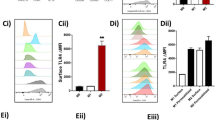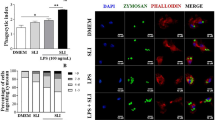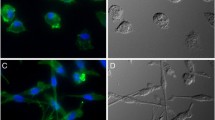Abstract
It is well established that exogenous RNA is incorporated into eukaryotic cells and is able to exert various biological responses. Little, however, is known about the effects of such RNA on macrophages. In this study, we demonstrate that RNA extracted from macrophages stimulated withEscherichia coli lipopolysaccharide (LPS), referred to as L-RNA, in contrast to RNA from non-stimulated macrophages (N-RNA), induces the release of a macrophage-derived neutrophil chemotactic factor (MNCF) and interleukin-8 (IL-8), from macrophage monolayers. The effect of L-RNA was dependent of the integrity of the polynucleotide chain and was not due to LPS contamination since its ability to induce MNCF and IL-8 release was strongly reduced by RNase but was not affected by DNase or polymyxin B. The poly A(+) L-RNA and poly A(−) L-RNA fractions were able to induce the release of MNCF and IL-8, indicating that the L-RNA could be acting at transcriptional and translational levels. The demonstration that actinomycin-D and cycloheximide inhibited the release of MNCF and IL-8 by, L-RNA-stimulated macrophages confirms this assumption. Fractionation of the total L-RNA by centrifugation on a 5–20% sucrose gradient showed that the L-RNA which sediments in the 4-5S region of the gradient is the only fraction capable of inducing the release of MNCF from naive macrophages. We have previously shown that macrophage monolayers stimulated with interleukin-1β or LPS release a low molecular RNA which also sediments in the same 4-5S region. Taken together, these results support our proposal that resident macrophages, when activated by injurious stimuli, in addition to secreting cytokines also release a low molecular weight (4-5S) RNA which may act on the surrounding macrophages to further stimulate the release of cytokines. This process would amplify the inflammatory response and would increase the mechanisms involved in the defense response or tissue injury.
Similar content being viewed by others
References
Mclean MJ, Renaud JF, Niu MC, Sperelakis N: Membrane differentiation of cardiac myoblasts induced in vivo by an RNA-enriched fraction from adult heart. Exp Cell Res 110: 1–14, 1977
Davis LA, Lemanski LF: Induction of myofibrillogenesis in cardiac lethal mutant axolotl hearts rescued by RNA derived from normal endoderm. Development 99: 145–154, 1987
Zucchi TMAD Passos Jr. GAS, De Lucca FL: RNA-mediated genetic transformation inEspergillus nidulans. Cell Mol Biol 35: 573–580, 1989
Passos Jr. GAS, De Lucca FL:In vivo induction of immunological memory to human tumor extract with poly (A)-containing immune RNA. Cell Mol Biol 34: 157–164, 1988
Passos Jr. GAS, De Lucca FL: RNA-mediated transfer of cellular immunity to a synthetic env antigen of the human immunodeficiency virus (HIV-1). Mol Cell Biochem 108: 1–8, 1991
Wolff JA, Malone RW, Williams P, Chong W Acsadi G, Jani A, Felgner PL: Direct gene transfer into mouse musclein vivo. Science 247: 1465–1468, 1990
Ferreira SH: Are macrophages the body's alarm cells? Agents Actions 10: 229–230, 1980
Ribeiro RA, De Lucca FL, Flores CA, Cunha FQ, Ferreira SH: RNA from LPS-stimulated macrophages induces the release of tumour necrosis factor-α and interleukin-1 by resident macrophages. Med Inflam 2:435–442, 1993
Ford-Hutchinson AW, Bray MA, Doig MV, Shipley ME, Smith JJH: Leukotriene B: a potent mediator of leucocyte function released from polymorphonuclear leucocytes. Int J Immunopharmacol 2: 232–236, 1980
Collins PD, Jose PJ, Williams TJ: The sequential generation of neutrophil chemoattractant protein in acute inflammation in the rabbitin vivo. J Immunol 146: 677–684, 1991
Faccioli LH, Souza GEP, Cunha FQ, Poole S, Ferreira SH: Recombinant interleukin-1 and tumor necrosis factor induce netrophil migrationin vivo by indirect mechanisms. Agents Actions 30:344–349, 1990
Rot A: Neutrophil attractant/activation protein-1 (interleukin-8) inducesin vitro neutrophil, migration by a haptotactic mechanism. Eur J Immunol 23: 303–306, 1993
Ribeiro RA, Flores CA, Cunha FQ, Ferreira SH: IL-8 causesin vivo neutrophil migration by a cell-dependent mechanism. Immunology 73:472–477, 1991
Cunha FQ, Ferreira SH: The release of a neutrophil chemotactic factor from peritoneal macrophages by endotoxin: inhibition by glucocorticoids. Eur J Pharmacol 129: 65–76, 1986
Dias-Baruffi M, Cunha FQ, Ferreira SH, Roque-Barreira MC: Macrophage-released neutrophil chemotactic factor (MNCF) induces PMN-neutrophil migration through lectin-like activity. Agents Actions 38: C54-C56, 1993
White BN, De Lucca FL: Preparation and analysis of RNA. In: R.B. Tunner, (ed.). Analytical Biochemistry of Insects. Amsterdam, Elsevier Sclentific, 1977, pp 85–130
Bertolini MC, De Lucca FL: Poly (A) — containing RNA from the spleens of mice with Chagas'disease triggersin vitro macrophage resistance toTrypanosoma cruzi. J Protozool 33: 81–84, 1986
Aviv H, Leder P: Purification of biologicaly active globin messenger RNA by chromatography on oligothymidilic acid-cellulose. Proc Natl Acad Sci USA 69: 1408–1412, 1972
Stewart PR: Inhibitors of Translation. In: P.R. Stewart, D.S. Letham, (eds). The Ribonucleic Acids. Springer-Verlag, Berlin, 1973 pp 151–158
Barnes PJ, Adcock I: Anti-inflammatory actions of steroids: molecular mechanisms. Trends Pharmacol 14: 436–441, 1993
Brannan CI, Dees EC, Ingram RS, Tilghman SM: The product of H19 gene may function as an RNA. Mol Cell Biol 10: 28–36, 1990
Lee RC, Feinbaum RL, Ambros V: The C. elegans heterochronic gene lin-4 encodes small RNAs with antisense complementary to lin-14. Cell 75: 843–854, 1993
Dray S, Braun DP: Some perspectives on the transfer of cell-mediated immunity by immune RNA. Mol Cell Biochem 25: 15–31, 1979
Beljanski M, Beljanski MS, Manigault P, Bourgarel P: Transformation ofAgrobacterium tumefaciens into a non-oncogenic species by anEscherichia coli RNA. Proc Natl Acad Sci USA 69: 191–195, 1972
Sokol S, Christian J L, Moon RT, Melton DA: Injected Wnt RNA induces a complete body axis inXenopus embryos. Cell 67: 741–752 1991
Brennan FM, Zachariae COC, Chantry D, Larsen CG, Turner M, Maini RN, Matsushima K, Feldmann M: Detection of interleukin — 8 biological activity in synovial fluids from patients with rheumatoid arthritis and production of interleukin-8 mRNA by isolated synovial cells. Eur J Immunol 20: 2141–2144, 1990
Van Zee KJ, Deforge LE, Fischer E, Marano MA, Kenney JS, Remick DG, Lowry SF, Moldawer LL: IL-8 in septic shock endotoxemia, and after IL-1 administration. J Immunol 146: 3478–3482, 1991
Cunha FQ, Lorenzetti BB, Poole S, Ferreira SH: Interleukin-8 as a mediator of sympathetic pain. Br J Pharmacol 104: 765–767, 1991
Author information
Authors and Affiliations
Rights and permissions
About this article
Cite this article
Ribeiro, R.A., Flores, C.A., Cunha, F.Q. et al. Partial characterization of the RNA from LPS-stimulated macrophages that induces the release of chemotactic cytokines by resident macrophages. Mol Cell Biochem 148, 105–113 (1995). https://doi.org/10.1007/BF00928147
Accepted:
Issue Date:
DOI: https://doi.org/10.1007/BF00928147




